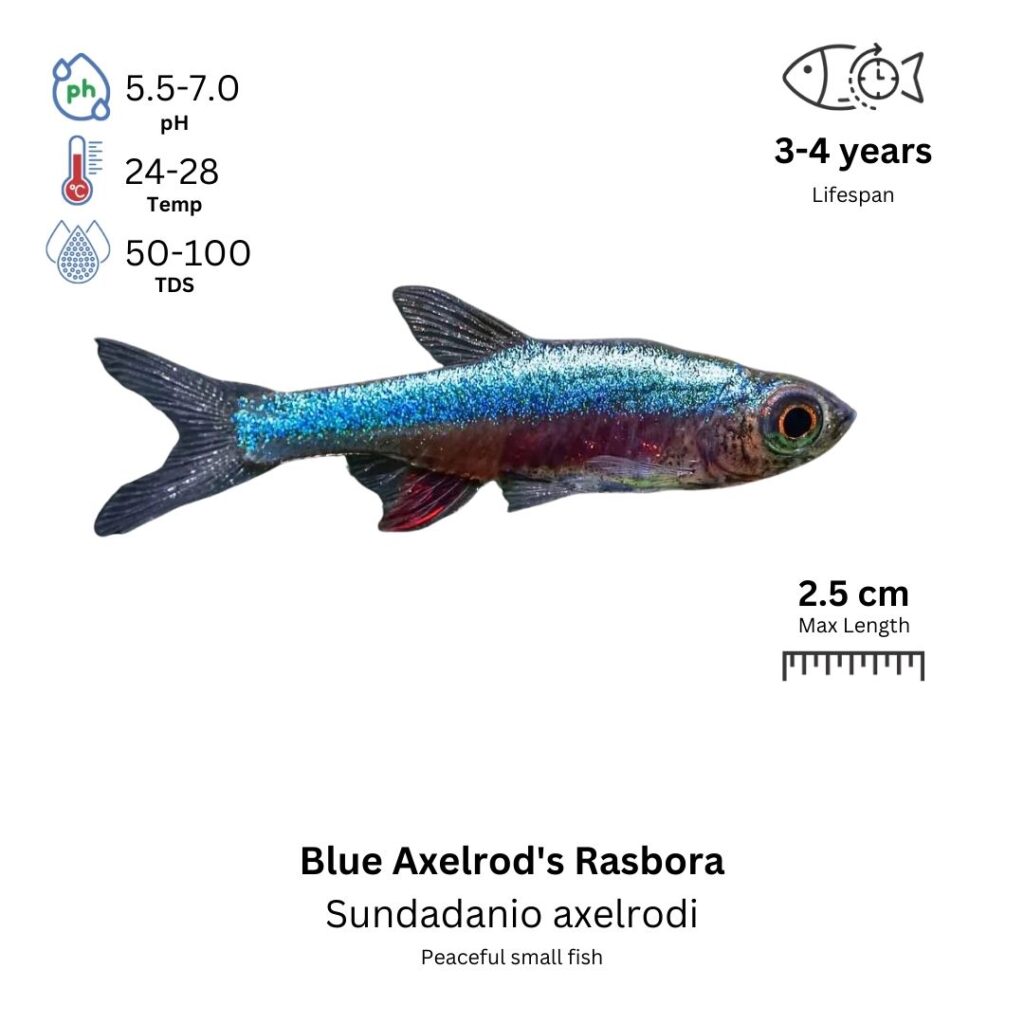Blue Axelrod's Rasbora
Rasbora ekremi

Description
Blue Axelrod’s Rasbora is a small, attractive species of rasbora known for its delicate body and vibrant coloration. The body of this fish is slender and elongated, with a metallic blue hue that intensifies under proper lighting, particularly along the upper body and fins. The lower portion of the body is typically a silvery white, with a faint reddish tint on the fins, especially during breeding seasons. The males are generally more colorful, exhibiting brighter blue hues, while females have a more subdued appearance.
Blue Axelrod’s Rasboras are peaceful and active swimmers, often seen darting about in the middle to upper regions of the tank. They are schooling fish and prefer to be kept in groups, where they feel more secure and display their natural social behavior. These fish are generally calm and non-aggressive, making them ideal for community aquariums.
Habitat Origin
Native to the tropical freshwater rivers and streams of Southeast Asia, particularly in areas like Thailand, Malaysia, and Indonesia. Blue Axelrod’s Rasboras inhabit slow-moving waters, often in heavily vegetated environments with plenty of hiding spots and submerged rocks. These fish are accustomed to slightly acidic to neutral water and thrive in environments with warm temperatures and good oxygenation.
Aquarium
Ideal Number in Aquarium: At least 6 individuals, as they are schooling fish and feel more secure in groups.
Favorite Food

Blue Axelrod’s Rasbora is omnivorous and will accept a variety of foods. They can be fed high-quality flake food, micro pellets, and live or frozen foods such as brine shrimp, daphnia, and bloodworms. They will also graze on algae and small plant matter in the aquarium. A varied diet will help maintain their health and vibrant coloration.
Behavior:
Blue Axelrod’s Rasbora is a peaceful and social fish that thrives in schools. They are active swimmers and are often seen darting through the middle and upper regions of the tank. These fish feel more secure in groups and display natural schooling behavior when kept in schools of 6 or more. While they are not particularly aggressive, males may exhibit some territorial behavior during breeding periods, especially when competing for mates. They are ideal for peaceful community tanks with other small species and can coexist with a variety of other fish, provided the tankmates are similarly peaceful.
Special Care:
Blue Axelrod’s Rasboras are relatively hardy but thrive in stable water conditions. They prefer a well-maintained tank with good filtration and regular water changes. They also enjoy well-planted tanks, where they can swim through plants and have plenty of hiding spots. Providing a fine substrate and live plants will help mimic their natural environment. These fish are best housed in aquariums with peaceful species, as they are not aggressive and may become stressed if kept with overly aggressive fish.
Compatibility with Other Fish:
Yes, Blue Axelrod’s Rasbora is compatible with many peaceful fish species. They can be housed with other small, non-aggressive species like tetras, other rasboras, small cichlids, and catfish. They can also coexist with shrimp and snails. Larger, aggressive species should be avoided, as they may stress or harm the rasboras. A peaceful community tank is ideal for Blue Axelrod’s Rasboras, where they can display their schooling behavior and vibrant colors.
Breeding Tank Setup
Setting up a dedicated breeding tank is highly recommended for Blue Axelrod’s Rasboras to effectively manage water parameters, minimize predation risks, and optimize spawning conditions. A 40-liter (10-gallon) aquarium provides adequate space for a small breeding group to exhibit natural courtship behaviors comfortably. These rasboras thrive best in slightly acidic to neutral water (pH 6.0–7.5), with temperatures ranging from 24°C to 28°C (75°F–82°F) and soft to moderately hard water (5–12 dGH). Gentle filtration using a sponge filter or low-flow internal filter helps maintain clean water without creating stressful currents. Incorporating fine substrates like sand or smooth gravel, complemented by live plants such as Java moss, Hornwort, Anubias, and floating plants like duckweed or water sprite, provides ideal surfaces for egg attachment and shaded retreats. Moderate lighting, replicating their dim natural habitats, ensures reduced stress and optimal breeding conditions.
Conditioning for Breeding
Conditioning Blue Axelrod’s Rasboras involves offering a nutrient-rich, high-protein diet to enhance reproductive readiness. Provide them with high-quality tetra pellets supplemented by live foods such as brine shrimp, daphnia, and bloodworms, alongside frozen foods like mysis shrimp. Maintaining consistent water quality through regular, small water changes (approximately 25% weekly) promotes spawning behaviors by mimicking the fresh, clean conditions they naturally seek for breeding.
Spawning Process
Blue Axelrod’s Rasboras exhibit egg-scattering behavior during spawning. Males display vibrant coloration, actively courting females through enthusiastic chasing. Females scatter about 20–50 adhesive eggs onto plants, rocks, or aquarium walls, with males fertilizing the eggs immediately afterward. It’s crucial to remove adult rasboras promptly post-spawning to prevent egg predation, as they do not exhibit parental care. Ensuring the adults are removed greatly increases egg survival and successful hatching rates.
Fry Care
Eggs typically hatch within 24 to 48 hours, dependent on water temperature. Initially, fry rely on yolk sacs for nourishment until becoming free-swimming. Once actively swimming, feed them infusoria, liquid fry foods, or microscopic algae. Within a few days, introduce baby brine shrimp or similarly sized live foods, gradually progressing to finely crushed flakes or small pellets as they mature. Excellent water quality is crucial; performing daily small water changes (around 10–15%), maintaining stable temperatures (24°C–28°C), and carefully monitoring ammonia, nitrite, and nitrate levels ensures healthy fry growth and minimizes mortality.
Important Breeding Notes
Blue Axelrod’s Rasboras typically reach sexual maturity around 6 to 12 months. Successful breeding requires ensuring fish are fully mature before spawning attempts. Males are distinguished by their slimmer bodies and brighter, more vivid colors (reds, oranges, and blues), particularly noticeable during courtship. Females tend to be larger, rounder, and paler, especially when gravid. Maintaining a stress-free environment by avoiding overcrowding, aggressive tankmates, and sudden water quality fluctuations greatly improves spawning success and overall egg survival.
